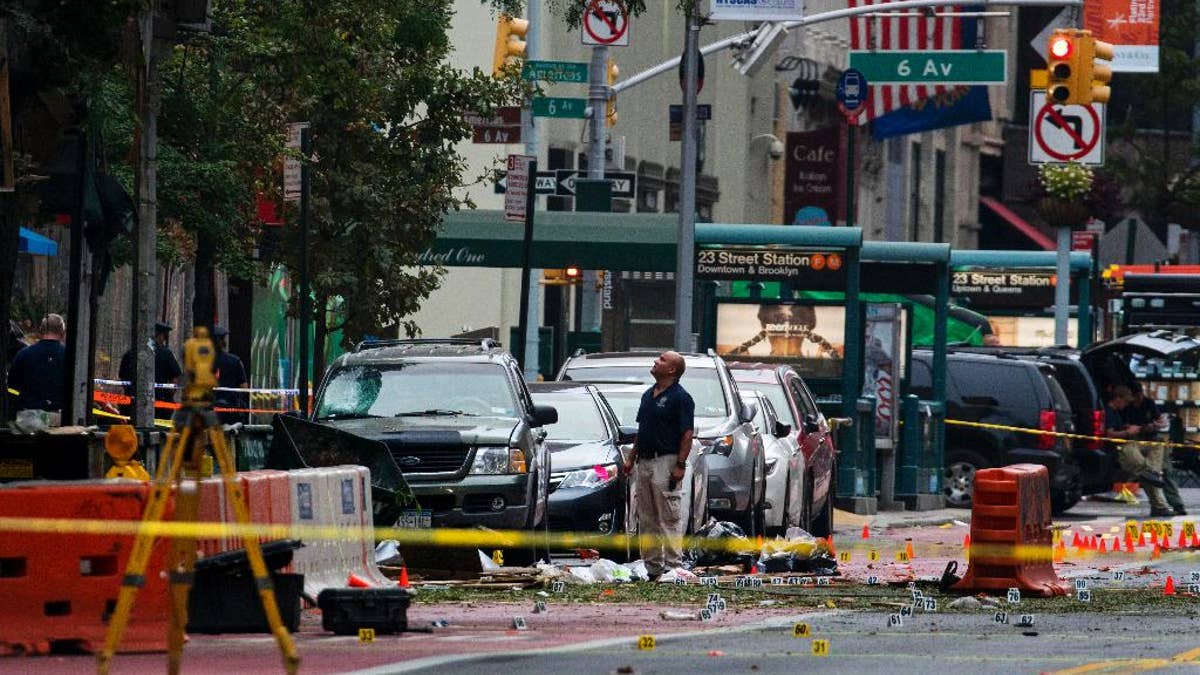
Sept. 18, 2016: Crime scene investigators work at the scene of Saturday's explosion in Manhattan's Chelsea neighborhood, in New York. (The Associated Press)
In the aftermath of the bombings carried out in New York and New Jersey, Americans are on edge. They know that federal law enforcement is stretched to the breaking point, working literally a thousand cases of Islamic State supporters.
In New York City proper, the epicenter of the latest attack an intelligence program that was once the envy of law enforcement and intelligence officials worldwide has been hamstrung by activists and grievance-mongers who seek to undermine effective counterterror provisions.
In this environment, hearing politicians like New York Mayor Bill de Blasio issue statements downplaying what common sense dictates were acts of terror leads regular Americans to believe that their government officials are unprepared.
In major cities law enforcement have repeatedly been targeted in ambushes, as occurred in Philadelphia and elsewhere. This leads U.S. police to prioritize their own “force protection” posture; so law enforcement can protect their ability to protect us. But it also means we need to do a better job providing our own security, a security which comes from better awareness.
Even the government itself says you have a responsibility for your safety. “If you see Something, say Something,” they urge, with calls to report, “suspicious packages.” But the guidance usually ends there. What are you supposed to see? What qualifies as suspicious?
Americans must develop better “situational awareness.” Too many Americans have their faces buried in Smartphone apps and games.
When you are out in public take a moment to see what’s around you.
To begin with, develop a baseline of your environment. Without an understanding of what “normal” is for your location (whether it's an airport, a train station, or on your drive to work) you won’t be able to tell what “suspicious” looks like.
We stop and look both ways before we cross the road because we realize we are entering a potentially dangerous environment. This is second nature and no one considers it a burden.
We should similarly stop and look whenever our environment changes. When we walk into a new building, or exit onto the street. Whenever our train stops at a new stop. Your environment has changed as new people get on, and some get off. That means it requires a new look.
We’re told to look for “suspicious” people and items but not what that means, in part because law enforcement doesn’t want to create a mental picture in your head of what “suspicious” looks like. -- That way you won’t limit yourself to seeing only what you were told to look for.
Instead ask the question, “Why”?
“Why is that man wearing a winter coat when everyone else is in short sleeves?” “Why did that woman have a bag when she entered and now she doesn’t?” There might be an obvious answer that puts you at ease, but remember it’s not your job to answer the question, only ask it.
Don’t explain away or rationalize behaviors. Call attention to the behavior if appropriate (“is that your bag?”), move away from the area, or find law enforcement. By asking the question “why?” you’ll able to explain what raised your suspicions and not feel hampered by political correctness or accusations about your character.
From the passengers on Flight 93 to the off-duty officer who ended the knife attack in St. Cloud, to the numerous occasions in between, it has been every day Americans, and not the government, who have successfully averted jihadist terror.
You owe it to those heroes, yourself, your family and your fellow Americans to be vigilant, maintain situational awareness and be uncowed in attempts to silence you from speaking up.
